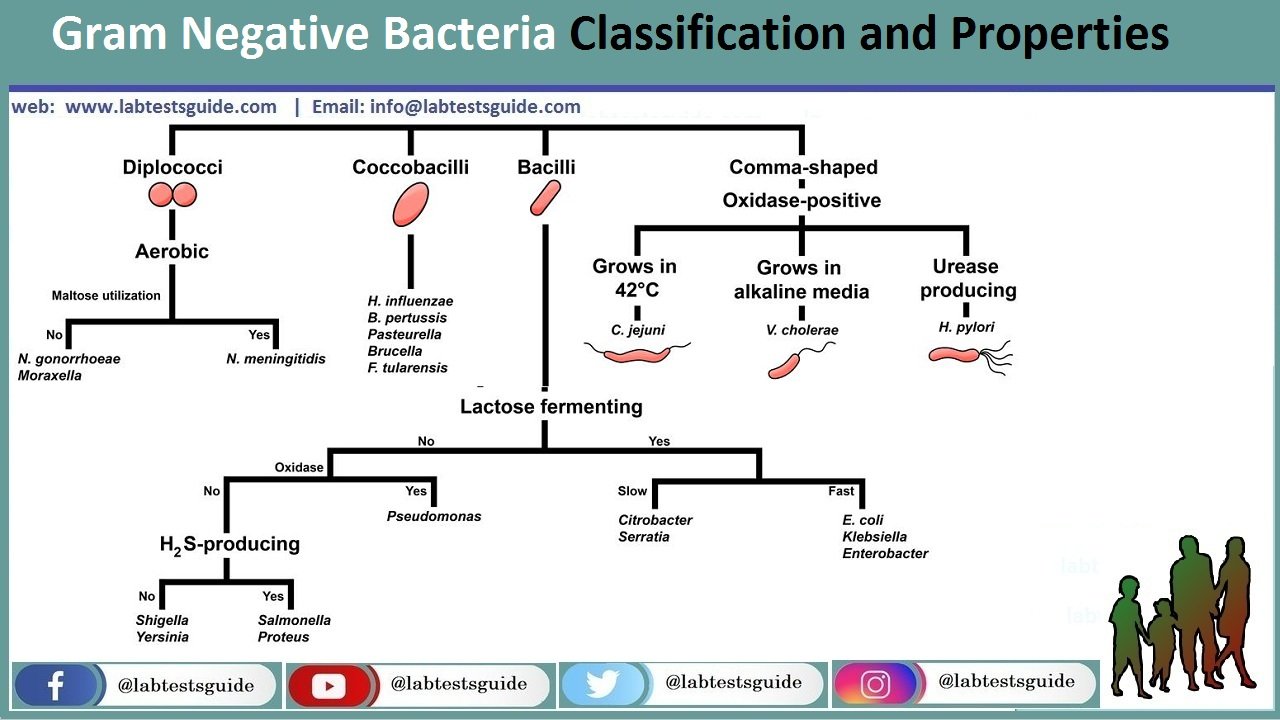2 Which of the Following Genus of Bacteria Is Gram-negative
A Treponema B Corynebacterium C Bacillus D Staphylococcus E Mycobacterium Answer. Modification of work by Bibliomaniac 15Wikimedia Commons.

Examples Of Gram Negative Bacteria Download Scientific Diagram
Further genera of Gram negative bacteria include Vibrio Campylobacter Pseudomonas and other bacteria which are normally found in the gastrointestinal tract.

. The small pink cells are. Pseudotuberculosis c Y. ENTEROBACTERIACEAE is a large family of bacteria that consists of more than two dozen genera.
B It is transmitted by ticks. A In this gram-stained specimen the violet rod-shaped cells forming chains are the gram-positive bacteria Bacillus cereus. 4B and two genera Leptotrichia and Fusobacterium were detected in the Gram-negative phylum Fusobacteria Fig.
It may digest the glue that binds cells together in tissues. It may promote adherence to host tissues. A distinctive feature of the family Enterobacteriaceae is that the cell diameter is 03 to 15 micrometers.
GENUS YERSINIA General characteristics. As a group they are commonly called enterics. However various strains of these bacterial groups can cause severe gastrointestinal disease.
Coprococcus occurs in human feces and uses carbohydrates as a major source of carbon and energy. Modification of work by Centers for Disease Control and Prevention Figure 5. Neisseria meningitidis causes bacterial meningitis and can also cause septicemia and shock.
They typically inhabit the colon of warm-blooded animals as normal flora. The small pink cells are the gram-negative bacteria Escherichia coli. Salmonella belongs to the Enterobacteriaceae family which is a huge family of gram-negative bacteria that share the following characteristics.
The most diverse class of gram-negative bacteria is Gammaproteobacteria and it includes a number of human pathogens. D It is gram-negative. The Stalked and Prosthecate Bacteria.
Normal flora of intestinal tract. Hydrobacteria are uniquely identified by a few conserved signature indel CSI in the HSP60 GroEL protein. There are several gram negative bacteria with medical significance.
Structure and Composition of the Acid-Fast Cell Wall. The main function of the enzyme _______ is to clot plasma and blood. B In this culture white colonies of B.
22 A primary difference between cyanobacteria and purple and green phototrophic bacteria is. C It is in the genus Rickettsia. Animals are natural hosts of yersinia and humans are accidental hosts of yersinia infection Short pleomorphic microaerophilic or facultatively anaerobic gram negative rods exhibiting bipolar staining with special stains Important human pathogens a Y.
E It is found in soil and water. Acid-fast bacteria are gram-positive but in addition to peptidoglycan the outer membrane or envelope of the acid-fast cell wall of contains large amounts of glycolipids especially mycolic acids that in the genus Mycobacterium make up approximately 60 of the acid-fast cell wall Figure PageIndex2. Akkermansia was identified in the Gram-negative phylum Verrucomicrobia Fig.
Cereus have been grown on sheep blood agar. A It is an intracellular parasite. Oxygenic Photosynthetic Bacteria Cyanobacteria.
However a conserved signature indel csi in the hsp60 groel protein distinguishes all traditional phyla of gram-negative bacteria eg pseudomonadota aquificota chlamydiota bacteroidota chlorobiota cyanobacteria fibrobacterota verrucomicrobiota planctomycetota spirochaetota acidobacteriota etc from these other atypical. Pseudomonas is genus of gram-negative bacilli that are aerobic and non-enteric meaning they use oxygen and are not found in the intestines. The cell diameter of bacteria belonging to family Enterobacteriaceae is ____________.
It may help in the evasion of host defenses by the deposition of fibrin around the staphylococcal cells. A total of 17 genera in the Gram-negative phylum Proteobacteria and 10 genera within the family Enterobacteriaceae were reported Fig. 119 12 Which of the following bacteria is gram-negative.
Piscirickettsia salmonis a non-motile Gram-negative bacterium that is responsible for high rates of mortality in marine animals causes the disease in salmonids known as Piscirickettsiosis 50. Microbiology Multiple Choice Questions on World of Bacteria I Facultatively Anaerobic Gram Negative Rods. Select all of the following that correctly describe the Streptococcus genus - Gram Negative - Gram Positive - Cocci - Bacilli - Tetrads - Sarcinae - Strepto - Staphylo - Fastidious - Can grow in salt - Can grow in acid - Normal flora of the skin Please explain if possible.
The conventional LPS- diderm group of gram-negative bacteria eg Pseudomonadota Aquificota Chlamydiota Bacteroidota Chlorobiota Cyanobacteria Fibrobacterota Verrucomicrobiota Planctomycetota Spirochaetota Acidobacteriota. Posted in MICROBIOLOGY Objective Questions. Neisseria meningitidis is diplococcus meaning that its spherical cells remain in pairs after cell division.
The most important of these are members of the family Enterobacteriaceae. For example a large and diverse family Pseudomonaceae includes the genus Pseudomonas. Bacteria of the genus Neisseria are examples of Gram negative cocci that cause disease in humans.
Posted on by Comments Off on 250 TOP MCQs on World of Bacteria II Gram Positive Cocci and Answers. There are more than 140 types of Pseudomonas. Yersinia 8 Escherichia coli 1 - Peritrichous flagella.
Facultative anaerobes meaning they can survive.

Gram Negative Bacteria Lab Tests Guide

Grampositive And Gramnegative Bacteria Bacteria Classification Different Genus Morphology Microbiology Vector Flat Illustration Stock Illustration Download Image Now Istock

List Of Yeasts Gram Negative And Gram Positive Bacteria Used In Download Table
No comments for "2 Which of the Following Genus of Bacteria Is Gram-negative"
Post a Comment